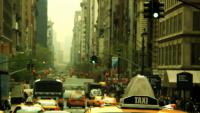Air Pollution/Contaminación del aire

(Español) Pollutants in the air we breathe can be bad for our health. Babies in the womb and young children are especially vulnerable as their bodies are growing and developing. Urban air in particular can often be more polluted than air in the surrounding regions. Street traffic is denser in cities. Industry, bus depots, and sewage treatment plants are sited near residential areas. And typical urban living in apartment buildings spreads secondhand smoke easily to many non-smoking homes. Indoors, fumes from heating fuels, cooking, and burning candles can build up in apartments, particularly when they are not well ventilated. Overall, partly as a result of air pollution, far more city dwellers struggle with asthma than people who live in the suburbs or rural areas.
From our studies, we learned that a lot of urban air pollution comes from heavy traffic. Trucks and buses are the worst polluters as they use diesel fuel. Trucks and buses without new emission controls can produce a lot of pollution, 50 times more than vehicles using gasoline. When diesel fuel burns, black carbon particles get into the air. The nose, throat, and lungs (upper respiratory system) can’t filter out black carbon particles because they are so small. These particles get deep into the lungs and can make breathing difficult. They can also worsen existing allergic and asthmatic conditions. Our studies show that black carbon from street traffic also comes indoors. Pollution-measuring machines placed in the homes of our study participants are finding nearly the same amount of black carbon inside homes as outside.
Pollution can originate from inside homes too. Our pollution measuring machines have found more tiny particles of polycyclic aromatic hydrocarbons (PAH) indoors than outdoors. PAH get into the air when fuel is burned. Common indoor sources are home heating fuels, tobacco smoke, cooking blackened foods, and burning candles and incense. See below for more on what you can do to reduce air pollution at home.
Some PAH are known to increase the risk of cancer. Our studies of mothers and newborns show that babies exposed to higher levels of PAH in the womb are born with cell damage that could increase their risk for cancer.
A combination of PAH and secondhand smoke increases health risks for children. All the babies in our study of mothers and newborns in Washington Heights, Harlem, and the South Bronx were exposed to PAH in the womb. But children who were also exposed to secondhand smoke have a higher risk of health problems:
-
Babies exposed to high levels of PAH and secondhand smoke in the womb were born smaller than babies exposed to low levels. At the age of two, they also scored lower on tests of learning ability.
-
Babies exposed to high levels of PAH in the womb and secondhand smoke after birth coughed and wheezed more as one-year-olds and had more breathing problems and probable asthma diagnoses as two-year-olds than those with lower exposures.
The good news is, there is a lot you can do to reduce harmful exposures at home. There are also clean air campaigns you can join to help lower air pollution levels in your community.
What You Can Do to Reduce Air Pollution at Home
-
Don’t smoke, and don’t let other people smoke near your children or in your home.
-
Don’t burn, char, or blacken food.
-
Use a kitchen fan while cooking.
-
Limit the use of candles and incense in your home.
Follow Healthy Habits to Lower Your Own and Your Children’s Cancer Risk
-
Eat five or more servings of fruits and vegetables every day.
-
Exercise regularly.
-
Avoid excessive weight gain.
-
Avoid eating burned, charred, or blackened foods.
Join Community Efforts on Behalf of Cleaner Air
Get involved with people in your neighborhood who are working to clean up the air. Community organizations coordinate effective clean air campaigns that are producing results. They are working to:
Reduce Air Pollution From Trucks and Buses
-
Allow fewer trucks and buses in residential neighborhoods.
-
Require trucks and buses to be equipped with new emission controls.
-
Prohibit trucks and buses from allowing their engines to idle when they stop for more than a few minutes.
Reduce Air Pollution From Waste Transfer Stations and Power Plants
-
Monitor pollution sources closely, ascertaining that the most current pollution control devices are being used and that operations comply with code.
-
Campaign to keep non-operational stations and plants closed.
-
Work to keep new stations and plants from opening in or near residential areas.
-
Increase residents’ environmental health awareness.
Educate Local Residents About Dangers to Their Health and to the Environment
-
Teach local residents to advocate for themselves and their neighborhoods.
-
Share knowledge of pollution sources and other relevant information with environmental and community groups citywide.
-
Collaborate with researchers at area universities to help learn about the health effects of pollution.